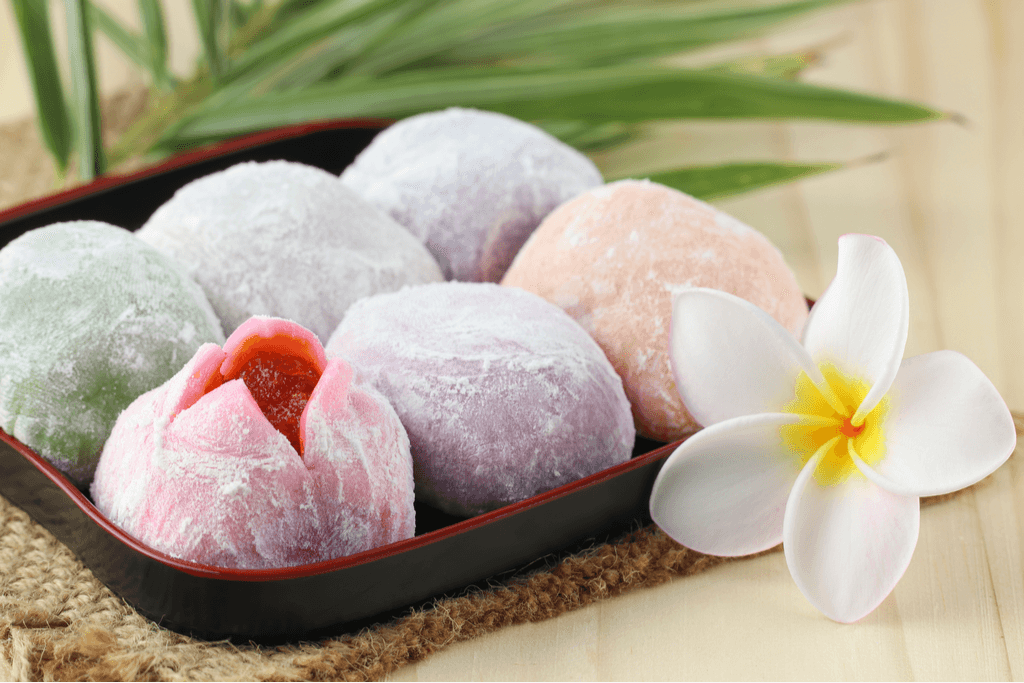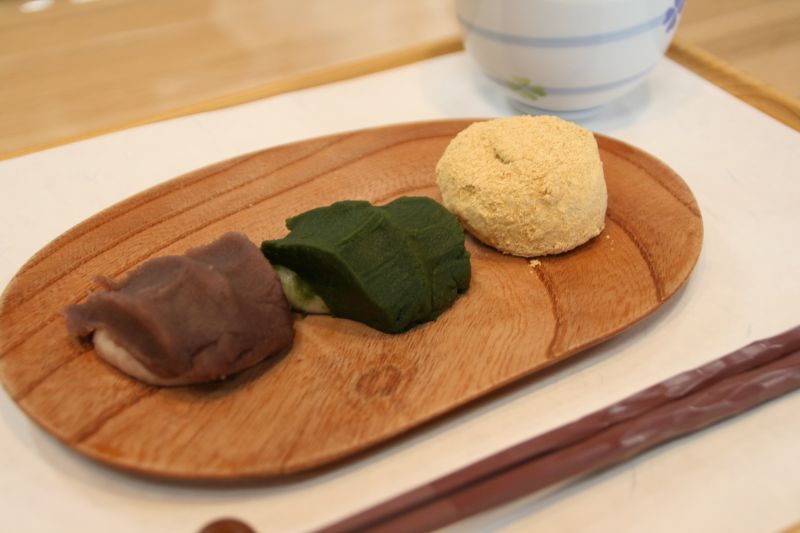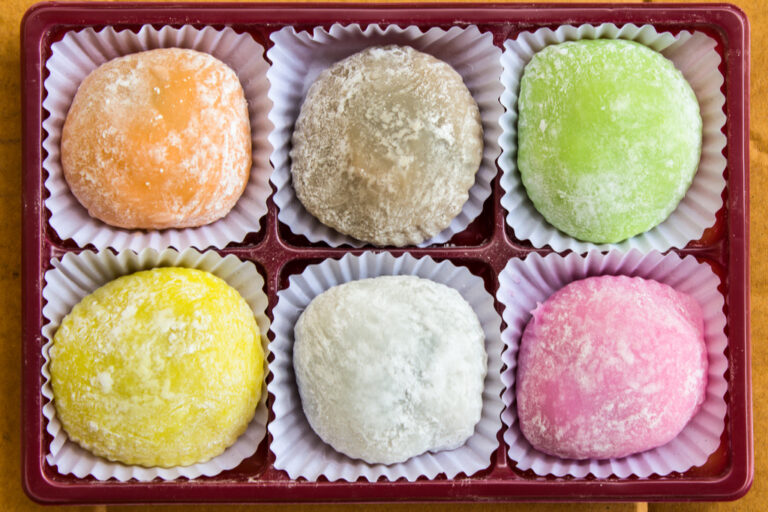Mochi has a subtle, mild taste that predominantly reflects the essence of rice. On its own, mochi is not strongly flavored, allowing it to serve as a versatile canvas for a wide range of sweet and savory fillings or accompaniments.
In addition, the true allure of mochi lies in its unique texture—soft, chewy, sticky, and slightly elastic. The pounding of rice during its preparation contributes to this distinctive consistency, creating a delightful eating experience.
Also, whether enjoyed in traditional forms with sweet red bean paste or wrapped around ice cream, mochi’s taste is often enhanced and complemented by the flavors it encases, making it a beloved and adaptable treat in Japanese cuisine.
What Is Mochi?

Mochi is a diverse category encompassing various styles and flavors of Japanese rice cakes. It is a unique dough crafted from pounded steamed rice, reflecting a culinary tradition deeply rooted in Japanese culture. This practice holds profound significance, as rice, a staple in Japan, plays a vital role in many aspects of life. The making and consumption of mochi are steeped in tradition, extending to Shinto rituals expressing gratitude to the gods for a bountiful harvest.
Moreover, in ancient Japan, it was considered a divine presence, a sacred food consumed for its believed health benefits and the promise of good fortune. Over time, it has evolved into a year-round delicacy with associations with diverse festivals and seasonal celebrations, including the Japanese New Year festivities. This enduring culinary tradition serves as a testament to the cultural and spiritual connections that mochi maintains in Japanese society.
Types of Japanese Mochi
Daifuku:
Daifuku mochi is a traditional Japanese sweet characterized by its large, soft, and round shape, filled with various sweet fillings. The most common filling is anko, a sweet red bean paste. However, it can also feature alternative fillings such as Ichigo (strawberry), providing a delightful variation to this popular treat.
Bota Mochi (Ohagi):
Bota Mochi, also known as Ohagi, offers a unique twist to traditional mochi. In this variant, the mochi ball is on the inside, while the outer layer is coated with fillings such as red bean paste. Enjoyed during the Buddhist holiday Ohigan, celebrated twice a year during the spring and autumn equinoxes, this mochi is called “botamochi” in spring and “ohagi” in autumn.
Kinako Mochi (Abekawa Mochi):
Kinako Mochi, also known as Abekawa Mochi in Shizuoka, features mochi sprinkled with sweetened kinako (soybean powder). The ideal way to enjoy this delicacy is when the mochi is freshly made and warm, enhancing the rich flavor of the soybean powder.
Kiri Mochi:
Kiri Mochi refers to basic blocks of mochi cut into rectangles in their preserved state. These versatile mochi blocks can be grilled or incorporated into various dishes, offering a convenient and adaptable option for culinary creativity.
Isobe Maki (Isobe Yaki):
Isobe Maki, or Isobe Yaki, involves grilling individual pieces of mochi, wrapping them in nori seaweed, and coating or dipping them in soy sauce. This simple yet delicious snack is best served warm with freshly made mochi.
Kusa Mochi:
Kusa Mochi, made from yomogi (mugwort), is naturally green and offers a unique fragrance. Typically filled with anko (red bean paste), this mochi is popularly sold during the springtime.
Yatsuhashi:
Yatsuhashi, a triangle-shaped mochi from Kyoto, is a common food souvenir. Filled with various options and featuring thin layers of mochi, the cinnamon-flavored yatsuhashi is a standout among its counterparts.
Hanabira Mochi:
Hanabira Mochi, shaped like a flower petal, consists of a thin layer of translucent white mochi surrounding a filling that includes a long slice of burdock root and red bean paste.
Sakura Mochi:
Sakura Mochi, sold during the spring for cherry blossom viewing season, is an extra-sweet pink mochi wrapped in a salty sakura blossom leaf. Typically containing red bean paste, this mochi provides a delightful contrast of flavors.
Dango:
While technically not mochi, dango shares similarities and is often categorized together. Typically served as three to five rice balls on a stick, dango is enjoyed in various colors during the hanami season.
Warabi Mochi:
Warabi Mochi, made from bracken starch, offers a jelly-like consistency. Rolled in kinako (soybean powder) and sometimes drizzled with kuromitsu (black sugar syrup), this mochi provides a unique textural experience.
Yaki Mochi:
Yaki Mochi is mochi toasted over a fire or hot coals, often consumed during wintertime. This type of mochi puffs up and becomes soft again as it is heated, offering a warm and comforting treat.
Mochi Ice Cream:
Mochi Ice Cream features a ball of mochi with ice cream inside, providing a delightful fusion of traditional mochi and a cool, refreshing filling.
Hishi Mochi:
Hishi Mochi, shaped like a rhombus, is a three-layered mochi symbolizing fertility. Sold around the time of Hina Matsuri, or the Girl’s Day festival, this decorative treat is associated with wishes for the health and success of girls.
Kagami Mochi:
Kagami Mochi, a New Year’s symbol, consists of two stacked mochi pieces topped with citrus fruit. The shape of this mochi resembles ancient copper mirrors, and it is prominently displayed during the Japanese New Year to bring good fortune and long life.
How to Make Mochi at Home?
To prepare homemade mochi, a delightful Japanese treat, you can follow these simple steps using just a few key ingredients: rice flour, sugar, water, and salt. This versatile recipe allows for customization with additional flavorings like matcha powder or soy sauce.
Here’s a step-by-step guide to making your mochi:
Ingredients:
- 2 cups rice flour
- 1 cup sugar
- 1/4 teaspoon salt
- 2 cups boiling water
Optional toppings or flavorings:
- Matcha powder
- Soy sauce
Instructions:
- In a large bowl, combine the rice flour with sugar and salt.
- Slowly pour boiling water into the dry ingredients while continuously mixing. Continue mixing until the mixture forms into a cohesive mass of sticky clumps.
- Cover the dough ball with plastic wrap and let it rest for about five minutes. This allows the dough to cool slightly.
- Prepare a surface for shaping the mochi by placing parchment paper or a silicone baking mat.
- Once the dough has rested, pat out bite-sized portions of it onto the prepared surface. Cover them again and let them soften for a bit before cooking.
- At this point, you can add optional toppings or flavorings such as matcha powder or soy sauce to enhance the taste of your mochi.
- Your mochi is now ready to be enjoyed! Experiment with different ingredients to make the cooking process an exciting adventure, and relish the soft and flavorful results of your homemade mochi.
How to Eat Mochi?
Mochi-Pops: Mochi is often shaped into smaller pieces and wrapped around ice cream, pudding, or fruit to create mochi-pops. This fusion of textures enhances the overall enjoyment of the treat.
Dango: In Japan, Dango refers to small balls of dough with a texture similar to mochi. The key distinction is that one type may have a filling inside, while the other does not. Dango is a popular variation enjoyed both as a snack and in festive settings.
Toppings and Fillings: It can be savored alone or with various toppings. Some prefer it without any topping, appreciating the natural taste and texture. Others may add red bean paste or white sugar syrup to enhance the flavor profile.
Temperature Variation: It can be enjoyed hot or cold. It can be eaten fresh out of the oven for a warm, comforting experience or straight out of the fridge for a refreshing treat during warmer weather.
Frozen Mochi on a Stick: In Japan, stores sometimes sell frozen mochi on a stick, a popular choice among children. This convenient and portable option adds a playful element to enjoying mochi.
Sweet Soups and Desserts: It can be incorporated into sweet soups or served as a standalone dessert. For example, it can be cooked in sweet soups or drenched in warm soy milk and sprinkled with sugar, creating a more filling and indulgent treat.
Mochi with Ice Cream: A newer variation involves it filled with ice cream. This allows individuals to experience two different textures simultaneously—the outer layer of soft mochi and the cold, creamy ice cream inside.
How to Store Mochi?

To ensure the longevity of your freshly made mochi and maintain its delightful texture, proper storage is essential. Follow these steps for effective mochi storage:
Cover with Protective Wrap: After making mochi, cover the surface with either plastic wrap or aluminum foil. This helps prevent moisture from affecting the texture of it and preserves its deliciousness.
Airtight Container or Sealable Bag: Transfer the mochi into an airtight container or a sealable bag. This step is crucial to shield it from humidity, which can compromise its soft and chewy consistency.
Freezing: Place the airtight container or sealed bag in the freezer. Frozen one can be stored for up to two weeks while maintaining its quality. Freezing is preferred over room temperature or refrigeration, as it stored in these conditions tends to harden quickly, altering its texture.
Avoid Room Temperature and Prolonged Refrigeration: It’s important to note that storing mochi at room temperature or in the refrigerator for an extended period can lead to quick hardening and a change in texture. Freezing is the recommended method to preserve mochi’s unique softness.
Quick Consumption Option: If you intend to consume it within a short timeframe, cover it with plastic wrap or aluminum foil and place it in a zip-lock bag. If tightly sealed, this quick consumption option allows you to store the mochi at room temperature for up to four hours.
How to Make Mochi Ice Cream?
Ingredients:
- 3/4 cup mochiko flour
- 1/4 cup white sugar
- 3/4 cup water
- 1 pint ice cream (recommended flavors: green tea, strawberry, chocolate, mango, or vanilla)
- Corn or potato starch
Tools:
- Small ice cream scoop or cookie dough scoop
- Plastic wrap
- Baking sheet or cupcake tin
- Large bowl
- Rubber spatula
- Rolling pin
- Knife
- Sifter (optional)
- Pastry brush (optional)
Directions:
- Using a small ice cream scoop, create eight balls of ice cream. Place each ball on a small piece of plastic wrap, twist to seal, and arrange on a baking sheet or in a cupcake tin. Freeze for at least 30 minutes.
- In a microwave-safe bowl, combine mochiko flour and white sugar. Add water and stir to achieve a crepe batter or icing-like consistency. Cover with plastic wrap and microwave for 60 seconds. Stir the batter, reseal, and microwave for an additional 30 seconds until set and slightly translucent.
- Liberally dust a baking sheet lined with plastic wrap with potato or corn starch. Scoop out it onto the sheet, add more starch on top, and lightly dust the rolling pin. Roll out the dough to a 1/4-inch-thick square or rectangle. Refrigerate for 15 minutes.
- Use a knife to cut the dough into eight equal pieces or use a 4-inch cookie cutter for uniform shapes. Remove excess starch with a pastry brush or by patting carefully.
- Place a ball of ice cream in the center of each mochi piece. Quickly wrap the dough around the ice cream, pulling up the sides, and pinch to seal the edges. Twist close using plastic wrap. Freeze immediately on the baking sheet or cupcake tin.
- Freeze it for at least 2 hours until solid. Unwrap a mochi ice cream ball and let it soften for a few minutes at room temperature before serving. Enjoy by taking a bite and savoring the delightful combination of it and ice cream.
Tips for Making Mochi Ice Cream
- The freezing process is crucial in making mochi ice cream. Work close to your freezer and focus on one mochi ball at a time. Once wrapped, immediately transfer it to the freezer to maintain the desired consistency.
- Prevent it dough from sticking by liberally dusting corn or potato starch on your work surface. Dust your rolling pin to prevent sticking as well. Use plastic wrap when chilling the dough in the fridge to avoid drying out and tearing.
- Handle it dough with care when rolling it out. Gently smooth it into a square or rectangle, making it easier to fold over the ice cream.
- Allow both the ice cream and mochi to fully set and chill before proceeding to the next step. This ensures a well-formed and stable mochi ice cream.
- If the dough becomes sticky, add a bit more cornstarch and pinch it back together if a hole forms. It dough is forgiving, so don’t stress if minor issues arise.
Recipe Variations for Mochi Ice Cream:
Add Extra Flavor: Customize the mochi dough by incorporating additional flavors. For example, add peppermint extract for a mint chocolate chip twist, almond extract for rocky road, or cocoa powder for a cookie dough ice cream pairing. Experiment with unique combinations, such as cayenne powder for a chili mango flavor.
Use Homemade Ice Cream: For a more adventurous approach, consider making your ice cream. Ensure proper chilling and churning to make the homemade ice cream easier to work with. Be mindful that homemade ice cream may be softer than store-bought, so be prepared for a potentially messier process.
FAQ’s
Does mochi taste good?
Yes, mochi is generally enjoyed for its sweet rice flavor and chewy texture. It is often paired with powdered sugar in Japan and can be particularly delightful when filled with ingredients like red bean paste (anko).
Is mochi sweet or savory?
Mochi can be both sweet and savory. Sweet mochi is often served with powdered sugar and can be filled with ingredients like red bean paste, black sesame paste, or peanut butter. Savory mochi is typically served with soy sauce.
Which mochi flavor is the best?
The best mochi flavor is subjective and depends on personal preferences. Popular mochi flavors include matcha green tea, red bean paste (anko), black sesame paste, and peanut butter.
Does mochi feel like balls?
Yes, Mochi has a unique chewy mouthfeel often described as ‘Q texture.’ It is similar to the texture of gummy bears. The sensation is distinct and might be overwhelming for some when paired with ingredients like red bean paste.
Is mochi healthy to eat?
Yes, Mochi is considered a versatile and healthy snack. It was historically popular among rice farmers and Samurai for its stamina-boosting properties. Mochi is rich in protein and free from cholesterol, making it a nutritious carbohydrate source.
Final Words:
The taste of mochi is subtle and rice-centric, providing a neutral foundation that allows its versatility to shine through. The true charm of mochi lies in its captivating texture soft, chewy, and sticky which, when combined with various sweet or savory fillings, creates a delightful culinary experience.
Furthermore, it serves as a blank canvas in Japanese cuisine, absorbing the flavors of its accompaniments while offering a unique and satisfying textural sensation. Whether enjoyed in traditional forms or innovative variations, mochi’s taste is inherently connected to its distinctive texture, making it a beloved and adaptable treat for those seeking a delightful harmony of flavor and consistency.

